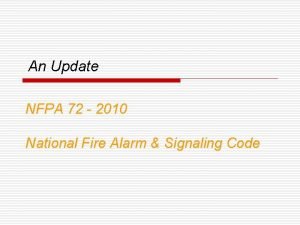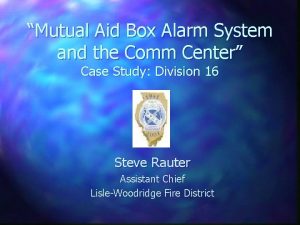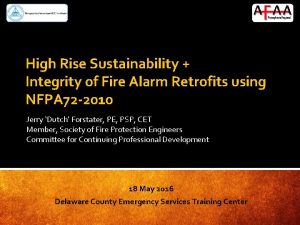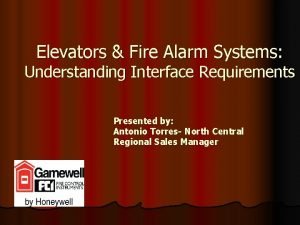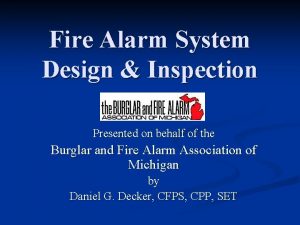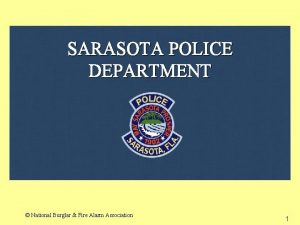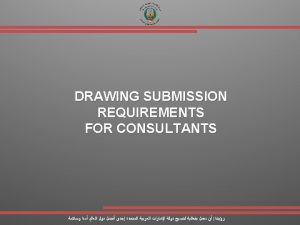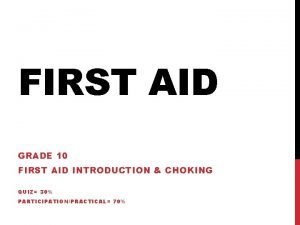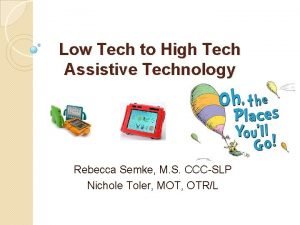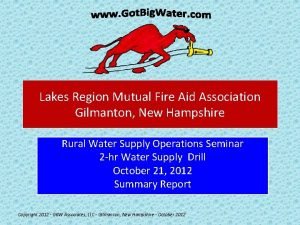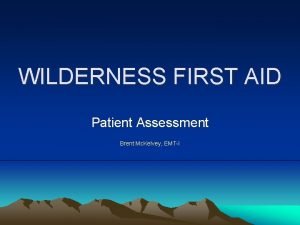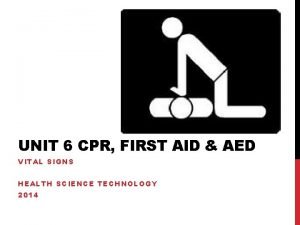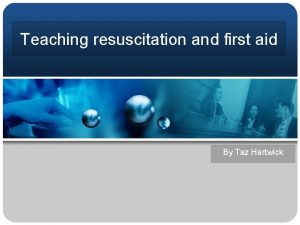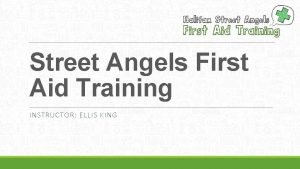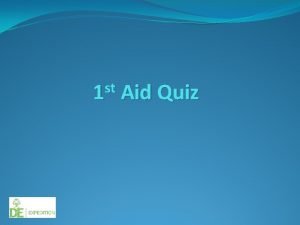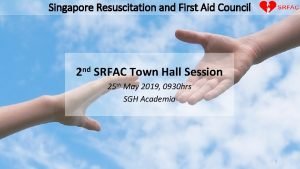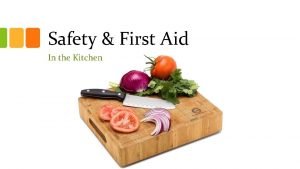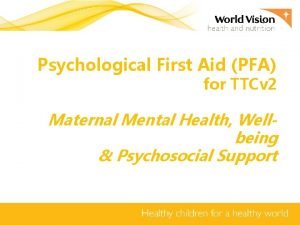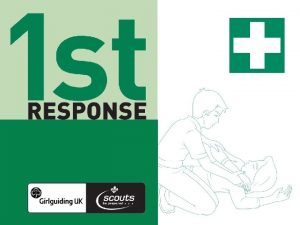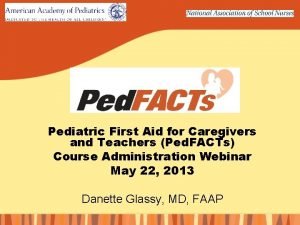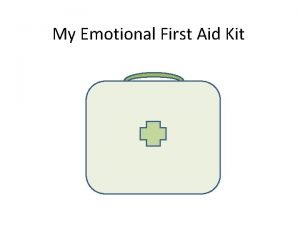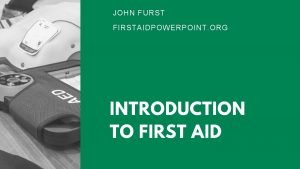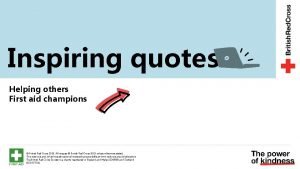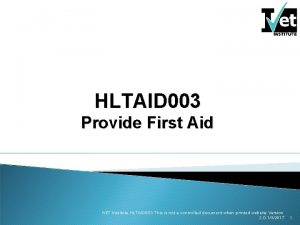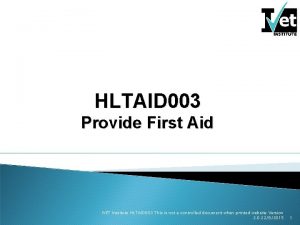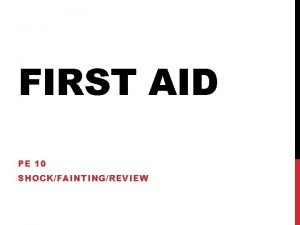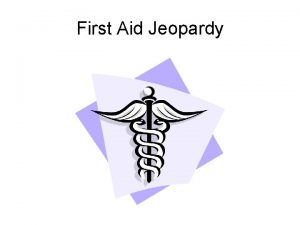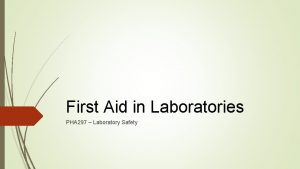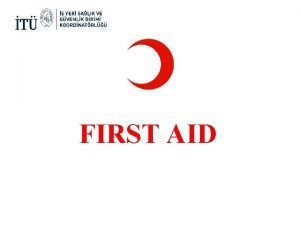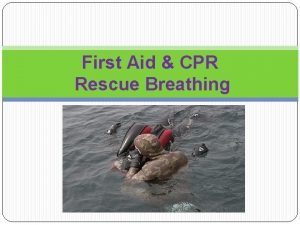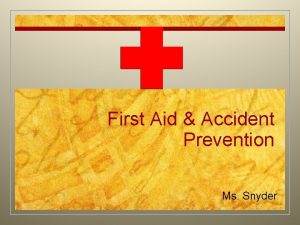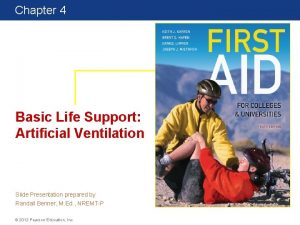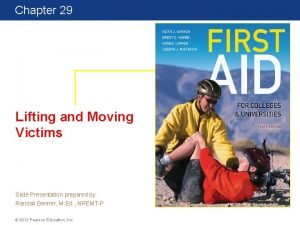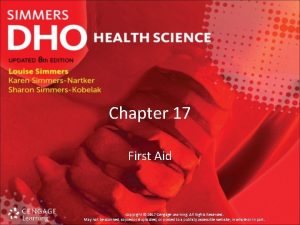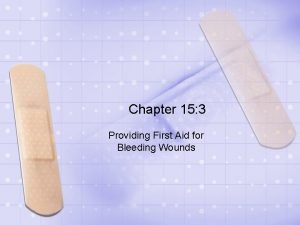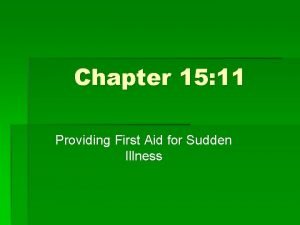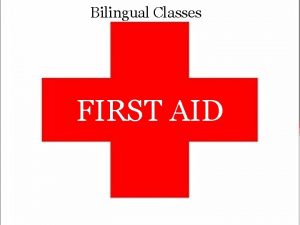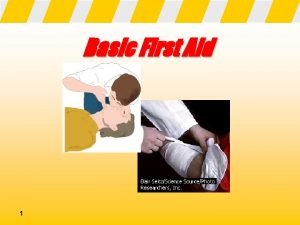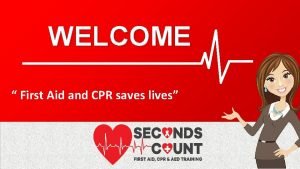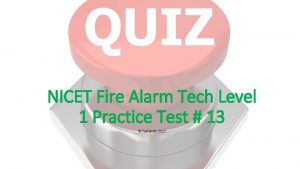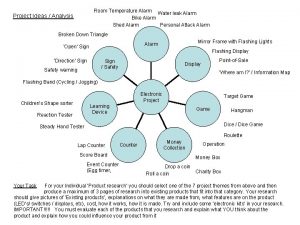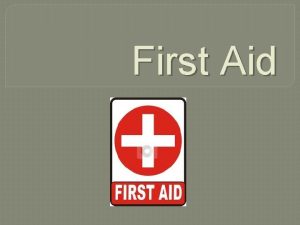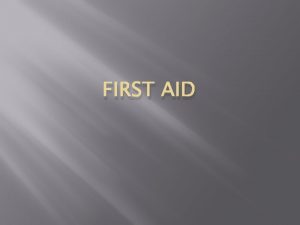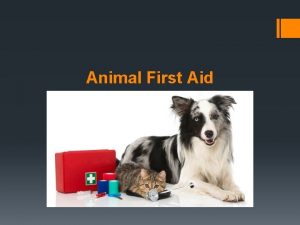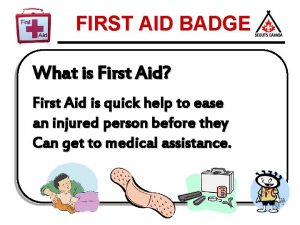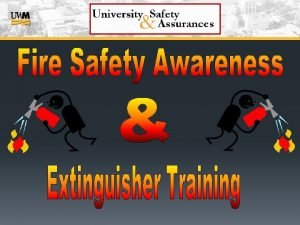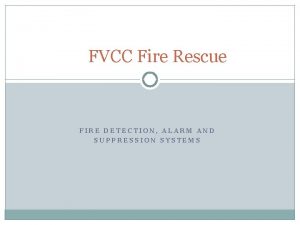NICET Fire Alarm Tech Level 1 First Aid
































































- Slides: 64

NICET Fire Alarm Tech Level 1 First Aid, CPR, AED #2 © Ted Smith 2017

• They will let you use your code book on the test and it can have highlights in it. • AFTER YOU ARE DONE WITH THE QUIZ. GO THROUGH AND FIND ALL THE CORRECT ANSWERS AND THEN HIGHLIGHT THEM IN YOUR CODE BOOK. YOU WILL FIND THEM FASTER ON THE TEST THAT WAY. • I BELIEVE YOU WILL HAVE MANY QUESTIONS ON THE TEST WHERE THE ANSWER COMES FROM A PLACE YOU HAVE HIGHLIGHTED.

Instructions • Be sure to place this presentation in Slide Show Mode if it is not already in that mode before proceeding • The purpose of this drill is to help you improve your skill at finding answers to questions using the applicable fire codes and also to help increase your knowledge of the Fire Alarm codes. • Each slide will contain a question. The question will remain in the screen for a period of 2 minutes. At the end of the two minutes, a notification will sound and the slide will transition to the next slide which will have the correct answer to the question. After 15 seconds the next question will appear and the process will continue. • During the test do not worry about the correct answers when those slide appear. You will be given an opportunity to review the answers with out the time at the end of the test. • Click on the slide to start the timer and begin the test

American Red Cross First Aid 1. When giving a rescue breath during CPR, each breath should last about: A. ½ second B. 1 second C. 3 seconds D. 4 seconds

• B 1 Second

American Red Cross First Aid • 2. If a person is suffering from pain or discomfort in the chest that lasts more than 3 -5 minutes or that goes away and comes back, this person is most likely having: • A. A cold related emergency • B. A heart attack • C. A heat related emergency • D. A seizure This Photo by Unknown Author is licensed under CC BY-SA-NC

• 2. B A heart attack

American Red Cross First Aid • 3. The cycle of chest compressions and rescue breaths in CPR is: A. 15 chest compressions for every 1 rescue breath. B. 15 chest compressions for every 3 rescue breaths. C. 30 chest compressions for every 1 rescue breath. D. 30 chest compressions for every 2 rescue breaths.

• D. 30 chest compressions for every 2 rescue breaths.

American Red Cross First Aid • 4. When you give care to an adult who is awake and choking, where should you position your fist to give abdominal thrusts? A. B. C. D. In the center of the breastbone In the middle of the abdomen, just above the navel On the rib cage Any of the above

• B. In the middle of the abdomen, just above the navel

American Red Cross First Aid. 5. Which type of injury involves an open wound in which the bone has torn through the skin? • • a. b. c. d. Dislocation Open fracture Sprain Strain

• b. Open fracture

American Red Cross First Aid 6. The general care for a muscle, bone or joint injury includes the following: a. Reduce, Insulate, Compress and Evaluate b. Rest, Ibuprofen, Cool and Evacuate c. Rest, Immobilize, Cold and Elevate d. None of the above

c. Rest, Immobilize, Cold and Elevate

American Red Cross First Aid 7. When caring for a person who is having a seizure, you should: a. Place a spoon or wallet between the person’s teeth. b. Remove nearby objects that might cause injury. c. Try to hold the person still. d. All of the above

b. Remove nearby objects that might cause injury.

American Red Cross First Aid 8. What sudden illness is usually caused by a blockage of blood flow to the brain? a. Diabetic emergency b. Heat-related illness c. Heart attack d. Stroke

d. Stroke

American Red Cross First Aid 9. This sudden illness results from too much or too little sugar in the person’s blood. What is it? a. Allergic reaction b. Diabetic emergency c. Seizure d. Stroke

b. Diabetic emergency

American Red Cross First Aid 10. Care for a person with exertional heat exhaustion includes the following: a. Force the person to quickly drink a lot of water. b. Get the person out of the heat and into a cooler place. c. Put more layers of clothing on the person as protection against the heat. d. All of the above

b. Get the person out of the heat and into a cooler place.

American Red Cross First Aid 11. Heat-related illnesses include the following: a. Fainting and hyperglycemia b. Exercise-associated muscle cramps, exertional heat exhaustion and heat stroke c. Exercise-associated muscle cramps, stroke and insulin shock d. Hypoglycemia and sunstroke

b. Exercise-associated muscle cramps, exertional heat exhaustion and heat stroke

American Red Cross First Aid 12. How should you care for someone with minor frostbite on the fingers? a. Get the person to a warm environment and then rewarm their hands using skin-to- skin contact. b. Have the person shake their hands vigorously until feeling is restored. c. Immerse their hands in hot water. d. Massage their hands vigorously.

a. Get the person to a warm environment and then rewarm their hands using skin-to- skin contact.

American Red Cross First Aid 13. What is the first step in caring for a wound with significant bleeding? a. Add bulky dressings to reinforce blood- soaked bandages. b. Apply direct pressure with a sterile or clean dressing. c. Apply pressure at a pressure point. d. Care for shock.

b. Apply direct pressure with a sterile or clean dressing.

American Red Cross First Aid 14. If an open wound continues to bleed heavily after applying direct pressure: a. Consider the use of a tourniquet or hemostatic dressing if pressure fails to control the bleeding. b. Do not remove the original blood- soaked dressing. c. Ensure that 9 -1 -1 or the designated emergency number has been called. d. All of the above

d. All of the above

American Red Cross First Aid 15. How do you care for a person with a possible head, neck or spinal injury? a. Move the injured area so that it rests above the person’s heart. b. Move the person into a comfortable position as soon as possible. c. Have the person remain still and not move their head. d. None of the above

• c. Have the person remain still and not move their head.

END of QUIz. THE TIME WILL STOP NOW. PLEASE CLICK ON THE SLIDE TO CONTINUE WITHOUT THE TIMER AND REVIEW EACH QUESTION.

American Red Cross First Aid 1. When giving a rescue breath during CPR, each breath should last about: A. ½ second B. 1 second C. 3 seconds D. 4 seconds

• B 1 Second

American Red Cross First Aid • 2. If a person is suffering from pain or discomfort in the chest that lasts more than 3 -5 minutes or that goes away and comes back, this person is most likely having: • A. A cold related emergency • B. A heart attack • C. A heat related emergency • D. A seizure This Photo by Unknown Author is licensed under CC BY-SA-NC

• 2. B A heart attack

American Red Cross First Aid • 3. The cycle of chest compressions and rescue breaths in CPR is: A. 15 chest compressions for every 1 rescue breath. B. 15 chest compressions for every 3 rescue breaths. C. 30 chest compressions for every 1 rescue breath. D. 30 chest compressions for every 2 rescue breaths.

• D. 30 chest compressions for every 2 rescue breaths.

American Red Cross First Aid • 4. When you give care to an adult who is awake and choking, where should you position your fist to give abdominal thrusts? A. B. C. D. In the center of the breastbone In the middle of the abdomen, just above the navel On the rib cage Any of the above

• B. In the middle of the abdomen, just above the navel

American Red Cross First Aid. 5. Which type of injury involves an open wound in which the bone has torn through the skin? • • a. b. c. d. Dislocation Open fracture Sprain Strain

• b. Open fracture

American Red Cross First Aid 6. The general care for a muscle, bone or joint injury includes the following: a. Reduce, Insulate, Compress and Evaluate b. Rest, Ibuprofen, Cool and Evacuate c. Rest, Immobilize, Cold and Elevate d. None of the above

c. Rest, Immobilize, Cold and Elevate

American Red Cross First Aid 7. When caring for a person who is having a seizure, you should: a. Place a spoon or wallet between the person’s teeth. b. Remove nearby objects that might cause injury. c. Try to hold the person still. d. All of the above

b. Remove nearby objects that might cause injury.

American Red Cross First Aid 8. What sudden illness is usually caused by a blockage of blood flow to the brain? a. Diabetic emergency b. Heat-related illness c. Heart attack d. Stroke

d. Stroke

American Red Cross First Aid 9. This sudden illness results from too much or too little sugar in the person’s blood. What is it? a. Allergic reaction b. Diabetic emergency c. Seizure d. Stroke

b. Diabetic emergency

American Red Cross First Aid 10. Care for a person with exertional heat exhaustion includes the following: a. Force the person to quickly drink a lot of water. b. Get the person out of the heat and into a cooler place. c. Put more layers of clothing on the person as protection against the heat. d. All of the above

b. Get the person out of the heat and into a cooler place.

American Red Cross First Aid 11. Heat-related illnesses include the following: a. Fainting and hyperglycemia b. Exercise-associated muscle cramps, exertional heat exhaustion and heat stroke c. Exercise-associated muscle cramps, stroke and insulin shock d. Hypoglycemia and sunstroke

b. Exercise-associated muscle cramps, exertional heat exhaustion and heat stroke

American Red Cross First Aid 12. How should you care for someone with minor frostbite on the fingers? a. Get the person to a warm environment and then rewarm their hands using skin-to- skin contact. b. Have the person shake their hands vigorously until feeling is restored. c. Immerse their hands in hot water. d. Massage their hands vigorously.

a. Get the person to a warm environment and then rewarm their hands using skin-to- skin contact.

American Red Cross First Aid 13. What is the first step in caring for a wound with significant bleeding? a. Add bulky dressings to reinforce blood- soaked bandages. b. Apply direct pressure with a sterile or clean dressing. c. Apply pressure at a pressure point. d. Care for shock.

b. Apply direct pressure with a sterile or clean dressing.

American Red Cross First Aid 14. If an open wound continues to bleed heavily after applying direct pressure: a. Consider the use of a tourniquet or hemostatic dressing if pressure fails to control the bleeding. b. Do not remove the original blood- soaked dressing. c. Ensure that 9 -1 -1 or the designated emergency number has been called. d. All of the above

d. All of the above

American Red Cross First Aid 15. How do you care for a person with a possible head, neck or spinal injury? a. Move the injured area so that it rests above the person’s heart. b. Move the person into a comfortable position as soon as possible. c. Have the person remain still and not move their head. d. None of the above

• c. Have the person remain still and not move their head.
 First aid merit badge first aid kit
First aid merit badge first aid kit Alarm
Alarm Survivability level fire alarm
Survivability level fire alarm Mutual aid box alarm system
Mutual aid box alarm system New age fire fighting company dubai
New age fire fighting company dubai Fire alarm sustainability
Fire alarm sustainability Definition news item text
Definition news item text Elevator shunt trip requirements
Elevator shunt trip requirements Canadian fire alarm association
Canadian fire alarm association Design and inspection of fire alarm system
Design and inspection of fire alarm system National burglar and fire alarm association
National burglar and fire alarm association Ravel fire alarm panel
Ravel fire alarm panel Riser diagram fire alarm system
Riser diagram fire alarm system Three ps in first aid
Three ps in first aid High tech low tech
High tech low tech Neasden and greenhill park medical centre
Neasden and greenhill park medical centre Lakes region mutual aid
Lakes region mutual aid Reichstag fire who was the fire starter
Reichstag fire who was the fire starter Fire hose reel signage standards
Fire hose reel signage standards Rwi are
Rwi are Race fire
Race fire First tech challenge engineering notebook examples
First tech challenge engineering notebook examples Wilderness first aid patient assessment form
Wilderness first aid patient assessment form Air cadet badge placement
Air cadet badge placement 6 vital signs first aid
6 vital signs first aid Unit 15:3 providing first aid for bleeding and wounds
Unit 15:3 providing first aid for bleeding and wounds Coyne first aid
Coyne first aid Taz hartwick
Taz hartwick First aid angels
First aid angels Three ps in first aid
Three ps in first aid National resuscitation council singapore
National resuscitation council singapore First aid kitchen
First aid kitchen Robot sensors ppt
Robot sensors ppt Psychological first aid
Psychological first aid Preserve life first aid
Preserve life first aid First aid for caregivers
First aid for caregivers Emotional first aid kit ideas
Emotional first aid kit ideas Three ps in first aid
Three ps in first aid First aid list quotes
First aid list quotes Injuries first aid
Injuries first aid Ivet institute
Ivet institute Hltaid
Hltaid Sea base first aid kit
Sea base first aid kit Rice first aid
Rice first aid What are the objectives of first aid?
What are the objectives of first aid? Pe shock
Pe shock First aid jeopardy
First aid jeopardy First aid in laboratory
First aid in laboratory Objective first aid
Objective first aid Ankle pull
Ankle pull Secondary survey cpr
Secondary survey cpr Llf in cpr
Llf in cpr Injuries first aid
Injuries first aid First aid for heat stroke
First aid for heat stroke Cocwa
Cocwa First aid for colleges and universities
First aid for colleges and universities Shirt drag first aid
Shirt drag first aid Chapter 17:5 providing first aid for poisoning
Chapter 17:5 providing first aid for poisoning Chapter 17:10 providing first aid for specific injuries
Chapter 17:10 providing first aid for specific injuries Chapter 15:3 providing first aid for bleeding and wounds
Chapter 15:3 providing first aid for bleeding and wounds Chapter 16:11 providing first aid for sudden illness
Chapter 16:11 providing first aid for sudden illness Preserve life first aid
Preserve life first aid Fundamentals of first aid
Fundamentals of first aid Emergency care first aid and disasters
Emergency care first aid and disasters First aid definition
First aid definition


